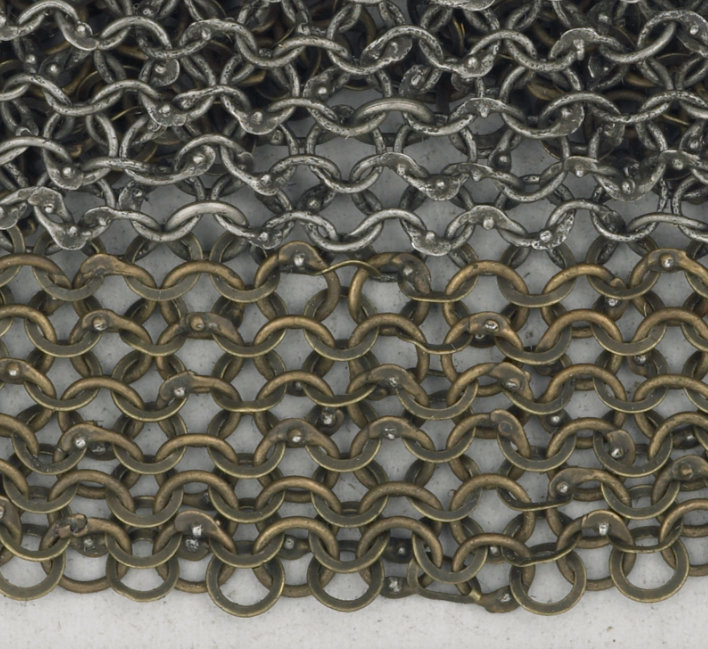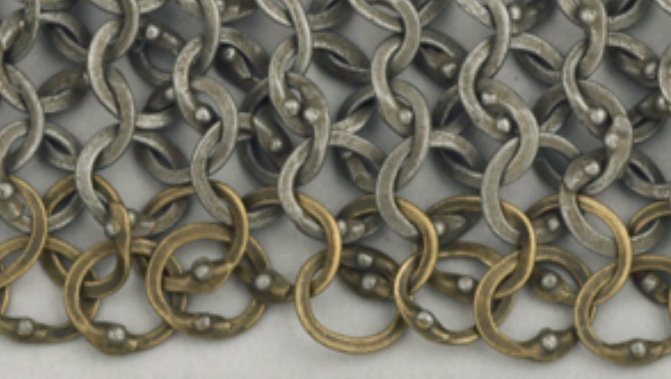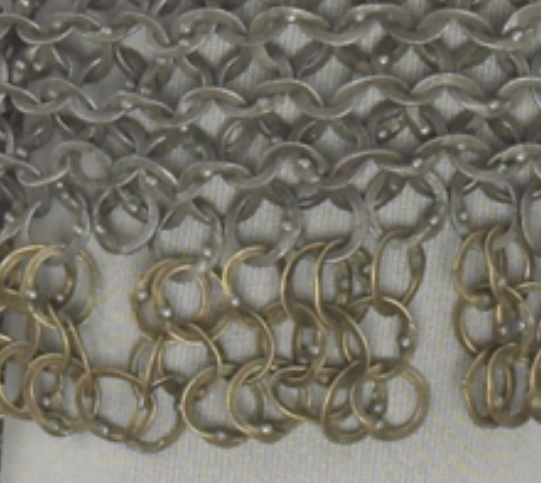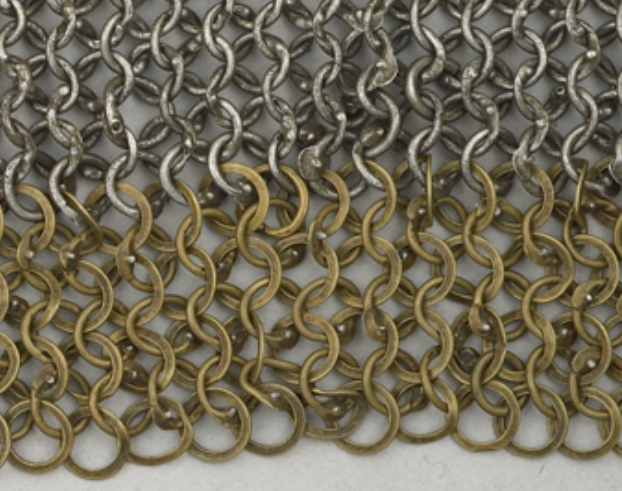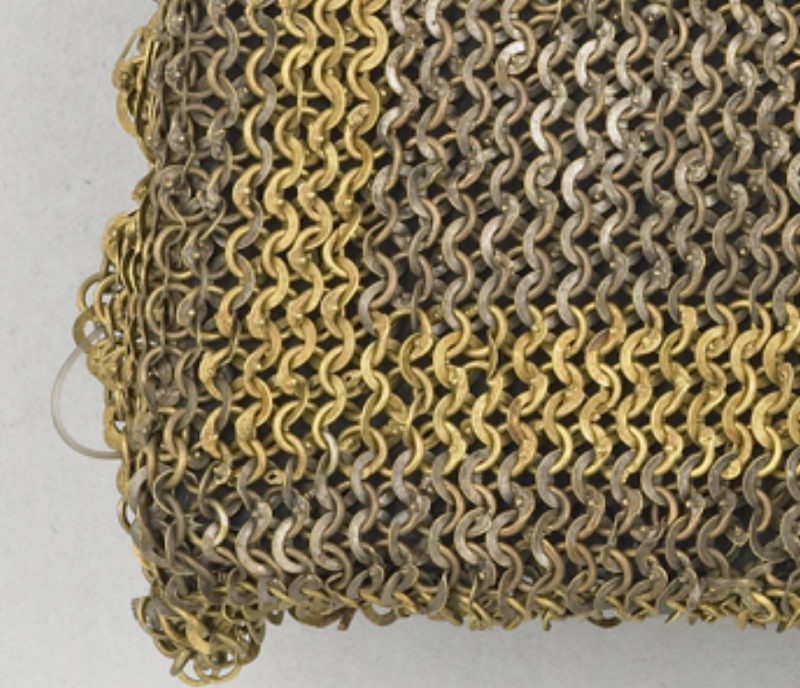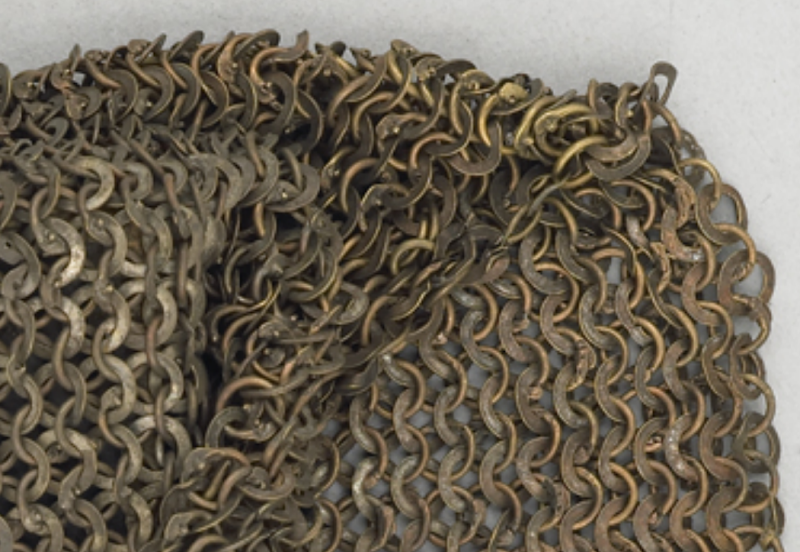Ernst wrote:Eric,
You may be pleased to hear that further research may overturn my argument in favor of brayettes being used as evidence for demi-riveted construction into the 15th century.
https://archive.org/stream/documentsete ... a_djvu.txt
1322. — ARMURES DU C0MTE DE FLANDRE.
Robert of Béthune, (Robert III, Count of Flanders) obit. 1322.
Item, unes braies de fier wambisiés.
Item, a braies of iron, gamboissed.
This would seem to indicate some mail brayettes might indeed date to the first 1/4 of the 14th century. We have already pushed Richardson's dates for mail sleeves back a few decades as well based on inventory listings.
Didnt Richardson already push the date of mail sleeves back to the earliest plate armors????

If your theory is correct, demi-riveted sleeves and brayettes like those at the Met might be earlier than previously believed.
FWIW, I don't agree with Dan's statement that Italian mail always uses round rivets. I haven't yet seen any evidence to contradict Erik Schmid's assertion that the watershed effect is German, but that doesn't mean I don't question it. And I have the greatest regard for Thom Richardson's research, though he's not infallible, either. All in all, I welcome your attempt at a timeline, as I have proposed similar ideas in the past. I think the difference is that I have now drawn back from trying to be so absolute. It's a good guideline, but I'm not yet convinced we can use it with any degree of certainty without more research to prove or disprove aspects of it.
-- Mart
Mart, we actually agree for the most part, the main problem as I see it is that while we can gather images in one place for study, getting the written references all in one place is much harder, right now they are spread over many different forum discussions, the brayette reference you just brought up is a great example of this. The period inventories can hardly be argued with except for some terms that have not been figured out yet such as "musekins".
I think that having a tenative timeline/progression, along with adding the known reliable references to this timeline/progression would be a great help to people trying to understand the history of European mail, it would also finally put all of the currently known reliable information in one place.
I personally agree with Richardson about demi wedge riveted mail, I can not see any evidence that it continued to be made past the point when all wedge riveted mail became the norm. Why would any mail maker go to the extra trouble of making demi riveted when the competition was not making demi riveted any more, it just seems logical that once wedge riveting became the accepted standard that the solid links were eliminated shortly afterwards.....just my personal opinion.
This is towards the end of Richardsons essay and it is well worth reading.
The detailed information provided by the privy wardrobe accounts about arms and armour in England during the period of the privy wardrobe is significant, and provides the single most extensive and important source on the subject. This again is unsurprising, given the importance of the accounts in the study of firearms in England for the same period.
The information is at its most profuse for the early period of the armoury. The accounts provide the richest single vein of information on the armour of the men-at- arms in England. For the first time we learn that mail sleeves, collars and paunces, rather than full mail shirts, were used from the very introduction of plate armour, and this enables us to reconsider the date of surviving defences, including examples in the Royal Armouries which may have survived from the period of the privy wardrobe. The accounts provide an explanation of a distinction between types of mail of fully riveted and of half riveted, half solid construction, which has never previously been understood, and which again allows the re-dating of surviving objects by over a century. Details of description of mail shirts of the same transitional period show the change from short to long sleeves and the provision of integral collars, which can again be observed in surviving examples which can be dated much earlier than hitherto.
The accounts provide details of the changing terminology of armour during this transitional period in the history of armour. Much of this is a transition from Latin to French terms: thus the mail thena becomes the coiffe, the antebracchia and retrobracchia of the 1330s become the avantbras and rerebras of the 1340s and 1350s, while other terms indicate a change in type, such as the mail collar, where the pisane of the 1330s, 1340s and 1350s was replaced by the standard from the 1360s; or the gauntlet, where the waynpayns for the tournament existed alongside the cerothes of plate for the field.
For some rare terms there is a large amount of new information, though they remain incompletely understood. The mail musekins found in the 1330s and 1340s are a good example; the accounts furnish substantial information about them, such as their issue along with mail aventail, collar, sleeves and paunces and a pair of plates, and their price. There is even a single reference to butted mail, of very large links for the tournament, in contradiction of the usual understanding that all such mail was either modern or Asian in origin. Jazerant mail appears much more in the accounts than would be expected, but appears alongside terms such as ‘privy tunic’ lined with mail, which ought to be synonymous. Mail of steel links was differentiated from that of iron links, and correspondingly twice as expensive. Mail shirts for the tournament were differentiated from those for the field, though we have no idea of the difference. Numerous examples of mail fully constructed of latten links are recorded, as opposed to mail garments with decorative borders or dags of latten links. All these are aspects of the study of mail which have been hitherto unknown.
The accounts provide the largest corpus of prices for armour in England for the fourteenth century. They show that where we might expect standardisation among products bought in great numbers, there was in fact wide variation in the prices of apparently identical items. For example, the purchases of the late 1360s by John Sleaford show that a regular shirt of riveted iron mail could cost anything between 16s. 1d. and £2 6s. 8d., while a mail shirt of steel links could cost between £3 6s. 8d and £4. Bacinets with mail aventails varied in price between 24s. and 17s.
By the 1370s the accounts for armour made for the king and members of the royal family show that the very finest pairs of plate could cost £4 13s. 8d., and the very finest complete armour could total £21, a sum roughly four times the price of a complete armour of plate in the middle of the fifteenth century. Despite the ostentation of the materials used in much of this armour, the silks, satins and velvets with which the pairs of plates were covered, it is quite clear from the accounts that this armour was intended for serious wear on the battlefield. Despite the importance of the tournament under Edward III, the Tower armoury retained only a very small quantity of arms and armour made specifically for the tournament, and most of this specialist gear was inherited by John Fleet from William of Langley in 1325, and passed on, unissued, to Robert Mildenhall in 1344.
Information about the sourcing of armour in the early period is also very interesting. Though the only previously published details suggested the Low Countries origin of much English armour of the mid-fourteenth century, the details in Fleet’s account confirm it, and show how important Cologne and Maastricht were as armour-making centres at that time.747 77% of the bacinets, 96% of the helms, 66% of the kettle hats, 84% of the pairs of plates, 83% of the arm defences, 86% of the gauntlets, 85% of the cuisses and 70% of the greaves were imported from those two centres. This makes the traditional ascription of the group of surviving great helms to English manufacturer highly improbable, and shows that they were much more likely to have been made in Maastricht. The accounts also challenge the traditional dating of this group of great helms for the field to the later fourteenth century, by providing evidence not only of their purchase and issue between 1338 and 1344, but of their return to the Tower in 1353 old and worn out, and their subsequent disappearance from the records in 1360 apart from a small rump which remained at the Tower for the next fifty years. The accounts also challenge the traditional assumption that the bacinet of the mid-fourteenth century was always or even usually fitted with a visor. Though it may be that many of the bacinets recorded in the accounts had visors which were not mentioned, only one, the personal bacinet of Edward III, is described as having a visor (or in this specific case, two visors).
One of the most fundamental ideas that the accounts challenge is the idea that before the fifteenth century there was no such thing as a complete armour, that armours were merely assembled from components by their owners rather than made as a homogeneous whole.748 From the late 1330s the accounts provide evidence that though plate armours were not manufactured as complete sets, armours were certainly issued to men-at-arms as full sets, such as the set comprising a helm, bacinet and aventail, mail collar, pairs of plates, rerebraces, vambraces, gauntlets, cuisses, greaves, mail paunces and sleeves given by the king to Sir Thomas le Brut in 1338. Numerous similar issues are recorded in Mildenhall’s accounts, where for the first time they are termed ‘complete armours’ (hernesia integra) in the accounts.
The issue of great helms with these armours in the 1330s and 1340s, taken together with the continued issue of horse armour during the same period, lends weight to the idea that the English armies expected to retain a reserve of mounted men-at-arms during this early phase of the Hundred Years War, for which evidence can be found in contemporary descriptions of the non-battles of the Weardale campaign of 1327 and of Buirenfosse in 1339, and that the ‘English system’ was not, at least at the outbreak of the war, as cut and dried as it is often perceived.








